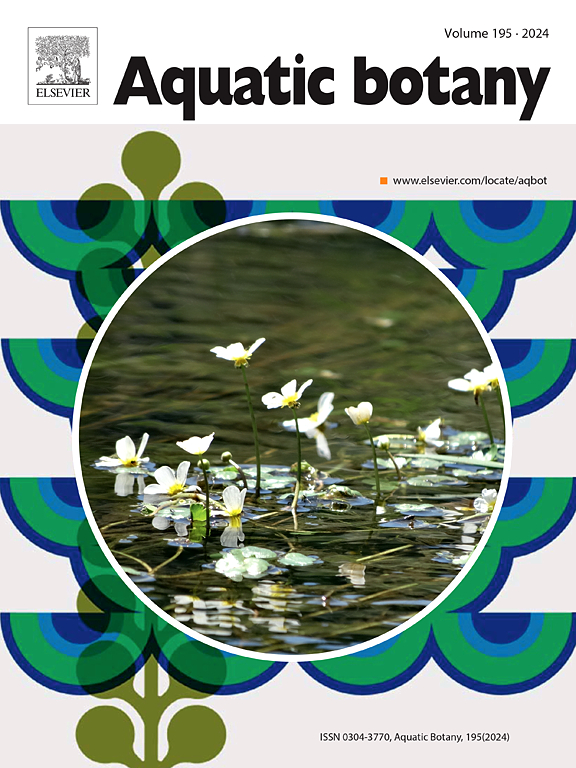Comparative studies of invasive Elodea canadensis Michx. in two climatically different regions
IF 2.6
4区 生物学
Q2 MARINE & FRESHWATER BIOLOGY
引用次数: 0
Abstract
Elodea canadensis is a widespread invasive alien aquatic species in Europe. However, there is growing evidence that increasing anthropogenic eutrophication and other factors are leading to a decline in the populations of this species. We compared the structure of plant communities and the phenotypic plasticity of E. canadensis individuals across communities in Ukraine and Portugal to assess whether the species responds similarly to environmental variation, and to identify differences in its distribution, community role, and the environmental factors influencing the formation of morphological traits of the species and biomass. In both countries, E. canadensis preferentially occurs in oligo-mesotrophic and meso-eutrophic waters, forming similar communities, but in Ukraine the communities in lentic water bodies were floristically more diverse. Populations with high biomass of E. canadensis in Ukraine were formed in lentic water bodies with good water exchange, as well as in lotic ecosystems of both Ukraine and Portugal. Environmental clustering revealed a distinct ecological separation among water bodies, with the strongest contrast observed between lower-nutrient, higher-elevation Ukrainian lakes and nutrient-rich, lowland mixed lotic systems in both countries. The morphological traits of E. canadensis differed significantly between these clusters, particularly shoot length and leaf width, highlighting phenotypic responses to environmental gradients. We assume that anthropogenic eutrophication affects E. сanadensis communities, and may lead to their decline or disappearance as trophic levels rise in both countries. Understanding these patterns is important for forecasting invasion dynamics under eutrophication and climate change, and for refining management strategies in freshwater ecosystems.
侵袭性加拿大弧菌的比较研究。在两个气候不同的地区
加拿大叶藻是一种在欧洲广泛存在的外来入侵水生物种。然而,越来越多的证据表明,不断增加的人为富营养化和其他因素正在导致该物种的种群数量下降。我们比较了乌克兰和葡萄牙不同群落的加拿大叶蝉的群落结构和表型可塑性,以评估该物种对环境变化的响应是否相似,并确定其分布、群落作用以及影响物种形态特征和生物量形成的环境因素的差异。在这两个国家,加拿大e.c anadensis优先出现在低中营养化和中富营养化水域,形成相似的群落,但在乌克兰,原生水体中的群落在区系上更为多样化。在乌克兰,在水体交换良好的水体中,以及乌克兰和葡萄牙的生态系统中,都能形成高生物量的加拿大沼虾种群。环境聚类揭示了水体之间明显的生态分离,在两国的低营养、高海拔的乌克兰湖泊和营养丰富的低地混合湖泊系统之间观察到最强烈的对比。在不同的植物群中,加拿大叶参的形态特征存在显著差异,尤其是茎长和叶宽,这突出了表型对环境梯度的响应。我们认为,人为的富营养化影响了沙蛙群落,并可能导致它们随着两国营养水平的上升而下降或消失。了解这些模式对于预测富营养化和气候变化下的入侵动态以及改进淡水生态系统的管理策略具有重要意义。
本文章由计算机程序翻译,如有差异,请以英文原文为准。
求助全文
约1分钟内获得全文
求助全文
来源期刊

Aquatic Botany
生物-海洋与淡水生物学
CiteScore
3.80
自引率
5.60%
发文量
70
审稿时长
6 months
期刊介绍:
Aquatic Botany offers a platform for papers relevant to a broad international readership on fundamental and applied aspects of marine and freshwater macroscopic plants in a context of ecology or environmental biology. This includes molecular, biochemical and physiological aspects of macroscopic aquatic plants as well as the classification, structure, function, dynamics and ecological interactions in plant-dominated aquatic communities and ecosystems. It is an outlet for papers dealing with research on the consequences of disturbance and stressors (e.g. environmental fluctuations and climate change, pollution, grazing and pathogens), use and management of aquatic plants (plant production and decomposition, commercial harvest, plant control) and the conservation of aquatic plant communities (breeding, transplantation and restoration). Specialized publications on certain rare taxa or papers on aquatic macroscopic plants from under-represented regions in the world can also find their place, subject to editor evaluation. Studies on fungi or microalgae will remain outside the scope of Aquatic Botany.
 求助内容:
求助内容: 应助结果提醒方式:
应助结果提醒方式:


